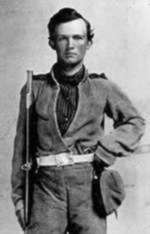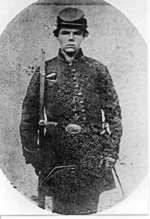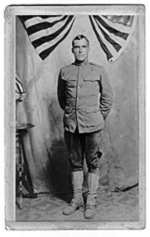 |
 |
 |
|
A Confederate Soldier, A Union Soldier --
and an American Soldier of WWI
|
||
 |
 |
 |
|
A Confederate Soldier, A Union Soldier --
and an American Soldier of WWI
|
||
Just as with the American Civil War, at the start of World War I, everyone expected the fighting would be over quickly. As with the Civil War, young men rushed to join up for fear of being too late to get in on the fighting and the "fun." In both cases, of course, the recruits didn't have to worry. The fighting lasted far longer than anyone could have expected, or wanted.
Before World War I, all the planners expected the railroads to play a major role in troop movements, and indeed they were right. The militaries of all the European nations developed massively complex plans for gathering in railroad cars and locomotives and using them to transport men and equipment toward the front. These plans took on such importance that the need to mobilize first, best, and fastest became one of the factors pushing the various nations toward war. The plans, once put in motion, could not be stopped halfway without stranding men and equipment far from where they were needed. However, all the plans relied on making use of civilian rail lines, cars, and locomotives, and on pulling civilians from their jobs and putting them in uniform. That in turn meant setting a mobilization plan in effect would disrupt the entire transport network and the whole economic life of the country. The planners and the experts told themselves that if they mobilized too soon, it could wreck the economy. Mobilize too late and that could risk losing the war before it started. Repositioning rail cars came to be seen as a potentially provocative act, almost an act of war. The planners were caught in a trap of their own making, and the mobilization plans themselves ratcheted up the threat of war.
What no one expected -- and what anyone who had studied the American Civil War probably should have expected -- was for the fronts to "congeal," and for the fight to bog down into trench warfare. From the coast of the English Channel to the border with Switzerland, the Western Front of World War I stretched the length of France in one essentially continuous lines of trenches. With few exceptions, the front remained static for four years, rarely moving at all, and only on a few occasions shifting by distances that might be measures in miles rather than yards or feet. The Western Front was the siege of Richmond and Petersburg reborn in a monstrously larger form.
It took much longer for trench warfare to develop in the Civil War -- something over three years, compared to the four or five weeks it took for the lines to stabilize and the trenchlines to be dug in World War I. At the start of the Civil War, it was almost considered cowardly, or just plain unsporting, to dig trenches and throw up fortifications. But even though neither side was able to develop offensive tactics that took the rifle into account, casualties on both sides finally taught soldiers to take cover. Early in the war, General Robert E. Lee was mockingly called the "King of Spades" because he so often ordered his men to dig in. By 1864, both sides had learned the skills of fortification, and would build a new defensive lines just about every time they took up a new position. It came to be said that soldiers used their shovels as much, or more, than their rifles.
Neither side in either war wanted trench warfare. Both sides in both fights struggled mightily to break out of the trenches -- indeed, for each and every one of the armies in question,.trench warfare itself almost became a second antagonist, as deadly as the opponents they faced. Trench warfare came again in World War I through the same causes as it had in the earlier fight. As in the Civil War, the standard-issues weapons were so deadly that no human being could survive long while standing within range of the enemy. That in turn forced the soldiers into trenches and fortifications -- and once in the trenches, there they stayed. The only real difference was that the weapons of World War I were even deadlier. It was probably this factor that drove the soldiers of World War I into the trenches so quickly. High-powered rifles, advanced artillery, barbed wire, and machine guns made it impossibly difficult -- even suicidal -- to move forward and attack -- while the trenches and dugouts and fortifications made it possible to stay put and defend a position almost indefinitely. A soldier in a trench is reasonably safe, and he can prevent the soldiers on the other side from advancing -- but he cannot advance, either. Each side can prevent the other side from taking action -- but at the cost of being forced into inaction themselves. Trench warfare equals stalemate.
In both Virginia of 1865, and France of 1918, all that was left was a battle of attrition. The fighting could only stop when one side or another was so reduced in numbers, so hungry, so worn down, worn out, so demoralized, that at last it gave way altogether.
In the case of both the Richmond-Petersburg siege, and the Western Front of World War I, railroads played a key role in supporting trench operations. The armies built their own rail lines for the purposes of supporting their forces -- and rupturing those rail lines was a tactical goal for all the armies in question. It was the Union breakthrough onto Lee's rail lines that finally forced him out of the trenches and into the open-country retreat that ended at Appomattox.
The railways allowed mobility on the way to the battlefield, and in the rear area of operations -- but they did nothing to provide mobility on the battlefield. It was not until after World War I that tanks, trucks and other transports got big enough, powerful enough and reliable enough that troops could regain the mobility that advanced weapons had taken away.
It is important to avoid the temptation of stretching a comparison too far. There were of course many vast differences between the two wars. One of them was, very simply, the rate of technological advance. In the Civil War, there was only one major weapon to be invented, sufficiently perfected, and then deployed and used in enough numbers to play a major role in the war: the ironclad fighting ship. All the other technical marvels that played a major role in the war had existed in fairly mature form before the fighting. The weapons and machines invented during the Civil War were, almost without exception, not really ready for large-scale use before the war was over.
That wasn't true in World War I. The battle tank moved from the drawing board to reality during the fighting. The fighter aircraft deployed at the end of the fighting were vastly more capable than the slow, unarmed scout planes that took off at its start. Gas warfare started with attacks so small that the enemy failed to detect them, but rapidly grew in sophistication and effectiveness , becoming a weapon that killed tens of thousand, crippled thousands more for life, and became a nightmare fear of every soldier.
But perhaps the most important lessons of the Civil War are taught by the First World War as well -- and nearly every war, for that matter. The fight is hardly ever as easy, or fast, or straightforward as the experts predict it will be -- and if a war lasts very long at all, it is going to take on a life of its own, even as it takes the lives of far more people than the experts ever expected. And, as was true for the Civil War, and World War I, and many others besides, over the course of the fighting, the goals of the fighting -- the war-aims of the combatant nations -- will change. Wars alter the world in ways no one ever expects.